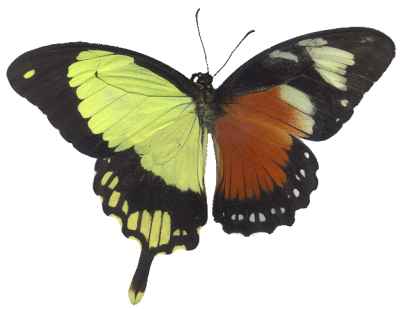Butterflies as Signal Receivers


This thesis examines the existence of colour preferences in butterflies. Two polymorphic species - the Mocker Swallowtail (Papilio dardanus) and the Silver-Washed Fritillary (Argynnis paphia) are used as study species. Both the basis of colour preferences in mate choice and flower choice during feeding, and the implications of the preferences for the evolution of the species and morphs are investigated.
In the Silver Washed Fritillary a non-genetically determined preference exists for highly saturated orange coloration in both mate and flower choice. This is shown not to be due to a bias for orange in colour reception through the use of electroretinograms, measuring the electrical output of the retina when exposed to light of varying wavelengths. It has not been possible, however, to rule out the possibility that the preference for the most common, orange, female morph is learnt.
The flower colour preferences of the Mocker Swallowtail are investigated, and it is demonstrated that individuals show an initial preference for blue flowers, and also learn rapidly to feed off flowers of other colours that prove profitable. Their decision to try flowers of other colours is shown to be influenced by the behaviour of other individuals. In previous mate choice experiments, experienced males of the species have been shown to have a preference for the most common, black and white, morph. The colours of the morphs and the spectral sensitivities of the butterflies are analysed quantitatively. The initial and subsequent preferences of naive males are investigated in behavioural experiments, and a possible influence of learning on their subsequent choices is discovered. No influence of female choice is found. This information is then used to create a mathematical model of the population structure, for which it is also necessary to determine the relative palatabilities of the model and mimic, and the mating frequency of wild males. The model demonstrates how the observed population structures might arise through evolutionary time.
Measurements of the morphology of males and females of Papilio dardanus, and one of its putative models, Danaus chrysippus, shows that in Papilio dardanus females the centre of gravity is positioned significantly further back than in males and in Danaus chrysippus. This positioning far from the wing base has already been shown to handicap an individual escaping from a predator due to decreased aerobatic ability. It has also already been shown that mimetic species tend to have centres of mass positioned further back than non-mimetic species, and hence it is possible that the position of a centre of mass of a butterfly (and its effect on agility) may be a factor in the evolution of mimicry in a species or (where females carry a large egg load) in females of a species only.
The work in this thesis would not have been possible without help from a great many people. I have included acknowledgements at the end of each chapter to thank those people who gave specific help, but there are many people who I would like to thank additionally for their help and support throughout the time I have been working on this project.
I would firstly like to thank my supervisor, Tim Guilford, for taking me on as a student, helping me design the project, and for all his help throughout the years I have been working on it. I am particularly grateful for his advice on writing up. Also Melissa Bateson, who first suggested that I look at Papilio dardanus, and who provided me with her own data and specimens.
Without the financial assistance of the my aunt Molly Jewell - who sadly never saw this thesis - and the additional support of my parents I might never have undertaken to do this work, and I would especially like to thank my father for proof-reading the entire thesis.
I would also like to thank Sir Cyril Clarke, Alison Gill and Dick Vane Wright for all their encouragement and for sharing their mine of knowledge on Papilio dardanus, and especially for the loan of brood books. I am deeply indebted to Yan Wong for explaining statistics to me, and correcting my misuse of statistical tests! I would not have been able to get hold of butterflies without the help of many people in the Entomological Livestock Group, and particularly John Calvert at Stratford Butterfly Farm. I have also been kept (relatively) sane with the help of many friends - members of the ABRG, Linacre, the Arcadians, Merton Choir, and New College Development Office.
Finally I would like to thank especially John Alden, who has put up with me and the butterflies for over three years, and without whom this thesis may never have been written, let alone made it onto the web!
|
Please cite this thesis as: Freeman, ALJ; 1998; D.Phil thesis, Oxford University. |
E-mail to Alexandra Freeman Back to Home Page |